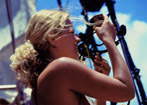|
Karang Kapota, Sulawesi

Celebrating new year at precisely 06° 04.910' S and 123° 00.83' E was a very significant moment on a very significant voyage for the RV Heraclitus. In these first seconds of the year 2002, we were on our way from the Komodo Island to Karang Kapota, an atoll off the southeast coast of Sulawesi, Indonesia. The ship had visited this reef briefly three years ago but this time we were returning to spend two weeks exploring its nooks and crannies, uncovering its secrets and most importantly, matching our findings to a satellite image of the reef.
PCRFís mission is to map and monitor coral reefs from space, to use the long-lens view of a satellite to watch over the reefs of the world and to ring alarm bells when there are changes taking place. For the last seven years, the RV Heraclitus has been collecting data underwater in the form of coral reef health and vitality statistics and video footage along designated transects. But this beautiful pixellated image of the reef at Karang Kapota was gold-dust in our hands. This represented a huge step forward in achieving our goal and it was significant for us to be carrying out this study in the heart of South East Asia, surrounded by reefs under the greatest threat of destruction and devastation.

The SPOT satellite image of the atoll
We had two weeks to collect as much information as possible, identifying ecological zones and developing a depth profile of the reef. This would enable us to fully understand what the satellite image is telling us about the condition of the reef now and help us to recognise what future changes in the image could mean.
Arriving at the atoll in the first place was not easy. The atoll is 11miles long and 4 miles wide but has only one entrance on its north west side. The swells and the winds raged around us for a day, obscuring our view of the underwater channel that would take us into the lagoon. They calmed enough for us to enter and anchor the next day. But we would continue to feel like we were still at sea for the following week as the ship was rocked and swayed by the metre and a half swells of the south-west monsoon.
Two teams worked like crazy for thirteen days, sweating under the blazing sun for eight hours at a time, hanging over the sides of the small boats with masks on and backsides in the air, scrutinising what lay below, making copious notes and recording it all on video. Within our two week schedule, the satellite image had been 'georeferenced' successfully and the code of the multi-coloured pixels broken down into a huge raft of data on the reef's ecological zones.
Our chief motivators during this project were Qamar Schuyler, a former Scientific Coordinator on the ship who has spent the last year land-locked, working for her Masters degree at the College of Charleston under Phil Dustan, a pioneer in the remote sensing of coral reefs. Qamar brought a colleague from her laboratory, Anne Blair. Between them they trained us in the techniques required to gather the data and kept the spirits high during the entire study.
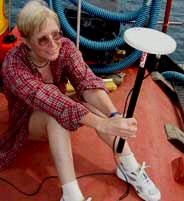
Anne testing the GPS equipment
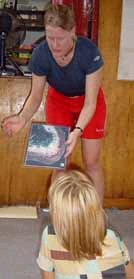
Qamar showing the crew, including 10 year old Priska, a close up of the satellite image
Gathering information in terms of zones, GPS coordinates and depths was only part of the process of building an overall picture of the current state of the reef at Karang Kapota. Three years ago the ship anchored here for just a couple of days from which Michel and Qamar have memories of exciting diving with large schools of pelagic fish including at least one shark each dive.
But on this visit, which fell in exactly the same annual season, there was a marked absence of large fish. Inside the reef, we passed over huge fields of coral which now looked more like the graveyards of an ancient sea civilisation. Massive colonies of porites fingers, huge tables of acropora and many other large monospecific patches were there, but instead of being full of life themselves and attracting life around them, they resembled skeletons, washed of their colour and smashed up in large patches. Just one lonely trigger fish roamed the area.
This reef is not an undiscovered reef. It may be what we would consider remote but that has not prevented its bounties from being exploited. Right now there stand upon the atoll five huts, built each season upon the corals. They are tiny constructions on stilts, very beautifully made, and each supporting a series of pens in which fish are held until they are large enough to sell. And the fishermen that live in these huts do not have to travel far to make the sale ñ the market traders come to them, all the way from Hong Kong, buying these groupers at low cost and transporting them live to where they can be sold for much more.
The local fishermen that have learnt how to manage groupers have also learnt where else and how else to catch fish. We were diving on the north wall of the atoll on one of the most pristine patches of reef I have seen in a very long time. But while down there, we felt three dynamite blasts. We surfaced to find fishermen in their canoes next to our small boat but these were not the culprits, the blasts had come from much further away. This is concrete proof of blasting but all the other signs are there on the reef too ñ patches of devastation within an otherwise healthy reef, pockets of macroalgae where the fertiliser from the bomb has fallen and fish in the fishermenís boats with distended bellies and exploding eyeballs from having been rocketed from the bottom to the surface by the force of the blast.
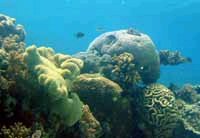
A patch of perfections where we heard the fishermen dynamiting
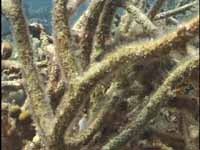 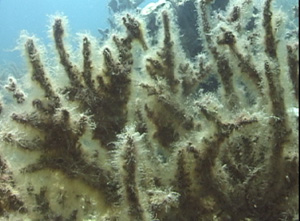

Patches of reef that show signs of having been blasted in the past
We saw very few sharks on the atoll, perhaps a result of the finning industry which has had devastating effects on all of South East Asia. When a bowl of shark fin soup can cost up to US $100, every fisherman will be tempted to catch the main ingredient, even if he will only receive a fraction of the price himself. The meat also makes great bait for catching groupers.
It would appear also that not just the fish have been drastically removed from Karang Kapota. There were hardly any sea cucumbers. This 'trepang' industry is rampant all over the world since sea cucumbers are easy to catch, easy to dry and easy to sell onto the Chinese. Another defenceless reef resident had suffered here ñ one of the huts was shielded on one side by a large pile of giant clam shells, clearly the fishermanís favourite treat.
The cetacean life at the atoll was more uplifting. On several days we were rewarded for our hard work by encounters with whales and dolphins. On the south-east side one of the science teams came within a couple of metres of several pods of whales ñ possibly false killer whales, also pilot whales. And on the north side we whiled away our surface interval between dives by watching the fishermen compete with an enormous pod of spinner dolphins for a school of tuna.
In all, it's very difficult to draw conclusions about the history of a reef and its inhabitants. It's also very tempting to jump to dramatic conclusions about its future. There are many things we do not know about Karang Kapota. But in just two weeks of observing what goes on there, we were able to gain a greater understanding of an atoll system, to make comparisons between the life on the outer walls, the reef crests and the back reefs inside the lagoon. And in correlating our information to the satellite image, we will hopefully have unlocked the key to realising when there are major changes occurring there in the future.
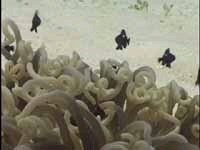
Dascyllus trimaculatus, juvenile three-spot dascyllus which, like the clownfishes, has a protection from anemone's stinging cell
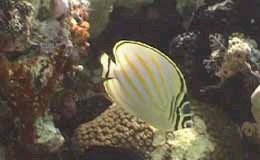
Chaetodon ornatissimus, ornate butterflyfish
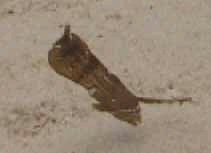 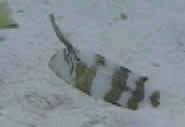

An exciting sighting - Xyrichtys pavo, the peacock razorfish juvenile, which mimics a waterlogged leaf, swaying like something caught in the surge - shown with its adolescent formation and its skill in camouflaging itself
|


